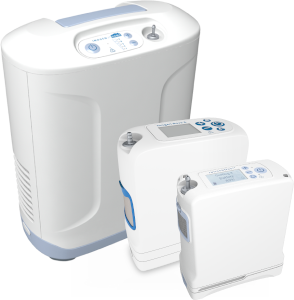When you are first learning about oxygen concentrators, you may be wondering, “What is a portable oxygen concentrator, and how does it differ from a stationary oxygen concentrator?” Though both a portable oxygen concentrator (POC) and a home oxygen concentrator unit operate in largely the same way when it comes to how air is processed, the primary difference is the size and where you use the unit.[1] Whether you only receive oxygen treatments at home, or whether you want to be able to continue your therapy out of the house, both portable and home units intake air, followed by a compression sequence, filtering and removing nitrogen before delivering purified, oxygen-rich air to you via the attached nasal cannula.[1]
What Are the Differences Between Stationary and Portable Oxygen Concentrators?
As its name suggests, a portable oxygen concentrator is designed to be used both in the home and on the go. As a result, these types of units tend to be more compact and lightweight while still providing essential oxygen for people with breathing issues and various types of chronic lung conditions. POCs use pulse dose technology, which means the oxygen is delivered to you when you inhale and is based on your breathing rate and other factors. Portable units are commonly small enough to carry, and fit easily in the average-sized automobile or under the seat in an airplane.[1] Plus, most major brands are approved by the FAA for travel on airplanes.[2] Inogen POC models are designed for portability, and meet FAA requirements for airplane use. Home (stationary) oxygen concentrators deliver oxygen continuously (at a steady rate) and need to be plugged into an electrical outlet to operate,[3] though some, like the Inogen At Home, may still be small enough to carry from room to room as needed.
Your doctor will help you choose the right oxygen concentrator for you. Here is a more detailed stationary and portable oxygen concentrator comparison so you can see the differences in the three styles of oxygen concentrators.
- Size: 8.15 inches tall, 7.19 inches long, 3.26 inches wide (with a single battery)
- Weight: 4.7 pounds (with a single battery)
- Sound level: 38 dBA at setting 2
- Flow Settings: 1-6
- Battery duration: Single battery = up to 6.5 hours; Double battery = up to 13 hours
- Comes with Inogen Connect and Bluetooth Mobile App
- Clinically validated for 24/7 use
- Size: 7.2 inches tall, 5.91 inches long, 2.68 inches wide (with a single battery)
- Weight: 2.8 pounds (with a single battery)
- Sound level: 40 dBA at setting 2
- Flow settings: 1-3
- Battery duration: Single battery = up to 2.7 hours; Double battery = up to 5 hours
- Comes with Inogen Connect and Bluetooth Mobile App
- Clinically validated for 24/7 use
- Size: 8.25 inches tall, 8.75 inches long, 3 inches wide (with a single battery)
- Weight: 4.8 pounds (with a single battery)
- Flow settings: 1-5
- Battery duration: Single battery = up to 4.7 hours; Double battery = up to 10 hours
- Clinically validated for 24/7 use
- Size: 16.5 inches tall, 7 inches long, 13 inches wide
- Weight: 18 pounds
- Flow settings: 1-5
- Provides 5 liters per minute of energy efficient, continuous flow oxygen
Choosing a Stationary vs. Portable Oxygen Concentrator
When it comes to a stationary and portable oxygen concentrator comparison, consider how your oxygen concentrator is used, as well as your present level of activity. You may wonder, “What is a portable oxygen concentrator best for, and when is a stationary unit better?” Think about whether you will need to travel, what flow level you require and how often you will need your oxygen treatments. While an Inogen home oxygen concentrator is small enough to travel around your home, it is larger than a unit designed to be portable. If you maintain an active lifestyle, and require regular oxygen therapy, our portable oxygen concentrators are designed for active patients who enjoy travel. However, if you are primarily homebound, or will need continuous flow oxygen, the stationary unit may be the right choice.[1]
The size of the unit is partially dependent on the kind of flow they provide. Home oxygen concentrators also often use what is called a “continuous flow system,” instead of the on-demand system that is used by most portable units. The on-demand system is one of the reasons that portable oxygen units can be designed as small as they are, while continuous flow requires a larger system.[1] The kind of flow your doctor prescribes will have an impact on choosing the right oxygen concentrator for your needs.
Choosing Inogen for Supplemental Oxygen
Whether you choose a stationary oxygen concentrator or a portable oxygen concentrator, both units can be moved around your home as needed, while the portable oxygen concentrators can also be taken out and about as needed. You should also maintain a secondary source of oxygen; for example, if you choose a stationary oxygen concentrator you may a portable oxygen concentrator as a back-up. Ask your doctor which oxygen concentrator best meets your needs, and contact us today to learn more about how Inogen can help you experience peace of mind, all day, every day.
Cited Sources
- Hardavella G, Karampinis I, Frille A, Sreter K, Rousalova I. Oxygen devices and delivery systems. Breathe (Sheff). 2019 Sep;15(3):e108-e116. doi: 10.1183/20734735.0204-2019. PMID: 31777573; PMCID: PMC6876135. Oxygen devices and delivery systems – PMC (nih.gov)
- Supplemental Oxygen Therapy: Types, Benefits & Complications (clevelandclinic.org)
- Getting Started with a Portable Oxygen Concentrator [Video] | American Lung Association









